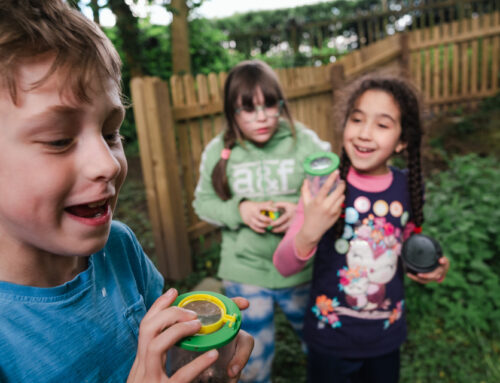Children with high learning potential, especially those who display Imaginational Overexcitability, can have the most wonderfully wild imaginations and immense creativity, but they may also find their overexcitability working against them. Their ability to visualise the worst possibility in any situation, for instance, can be less than ideal in unsettling times. How do you support children with imaginational overexcitability?
1. Understand their overexcitability
In some ways, a child with imaginational overexcitability might appear to be well-equipped to cope stressful situations, with a dive into their world of imagination just moments away. However, this overexcitability may also disadvantage them, as they catastrophise, find themselves unable to rein in unwelcome visualisations and develop worry and anxiety that may require our intervention and support.
By getting to know the various ways in which imaginational overexcitability can express itself, you will be more prepared to anticipate issues and to support your child effectively. Getting to know both the positive and negative side of it makes a parent much better placed to help them to maximise the one side and minimise the other. The mere knowledge that their parents understand them and their overexcitability is a simple yet valuable comfort.
2. Comfort and reassure
The imagination can go to scary places. As obvious and simple as it may seem, being there for comfort and reassurance and to allay any fears as much as possible, is an important aspect of supporting a child with imaginational overexcitability. Being well stocked up with cuddles and cheer up chats (the acceptable items to stockpile!) is vital.
3. Help them to manage their worries
If a child with imaginational overexcitability can arm themselves with a variety of strategies that can help them to manage their fears or worries, then not only will they have the tools to overcome the negative side of their overexcitability, but the sense of control and agency will have a generally positive effect on their overall wellbeing, too.
Mindfulness activity books such as Be Brave! and No Worries! can often help to rein in many fears borne out of an active imagination. Such books have the benefit of utilising techniques ideally suited to a child with imaginational overexcitability, as the doodling, drawing, writing and constantly creative activities really harness their imagination, helping it to become part of the solution.
Mindfulness activity book or not, writing down or drawing their worries can often be of great use. Getting it out and onto paper often lessens the power it has anyway, and if they are happy for you to see their work, then you then have more details to work from, which helps to give considered reassurances to their specific concerns.
You could also regard their trusty bookshelves as valuable tools. Their favourite books or audio books can justifiably be seen as positively therapeutic; whisking their mind away from negative thoughts and redirecting those imaginings to happier lands. Heading off to a quiet reading corner can be a simple but effective option for a child, in helping them to manage their feelings.
For more ideas for the toolbox, see our advice sheet PA606 Worry and Anxiety in High Learning Potential Children.
4. Exploit their superpower!
The positivity of your child’s creativity is not limited merely to situations when they need to manage their worries. It is so much more than that. With their creativity often comes a wonderful sense of humour and there’s nothing more therapeutic than laughter. Let their imagination run wild, as long as the focus is positive and really encourage their magical thinking. They can go to different lands, visit imaginary friends, be any species they like and never limit themselves to the banalities of the here and now. They could create poetry, prose, plays, pen anything they like, draw or daydream, with no particular or pressing reason to do so other than thoroughly enjoying themselves and, yes, if they’ve been at all worried, they can create fantastical ripostes with their imagination where they are the superhero who saves the day; where everyone is safe and together again; where anything can happen as long as it makes them feel better! Help them to express their imagination and improve their wellbeing.
5. Take opportunities not to have to conform
Children with imaginational overexcitability can sometimes encounter trouble in school as their daydreams get the better of them when they should be doing something else. Away from the constraints and confinements of a school day, let them indulge their overexcitability and, more than likely, feel an increased sense of wellbeing as the result.
Particularly in the holidays, give them the space and opportunity for flights of fancy, daydreams and allowing the imagination to go where it desires and have plenty of craft stuff and paper to hand for them to make wonderful creations in all sorts of different forms and genres.
6. Check their level of challenge or school environment
Has your child’s school been flaggin up “bad behaviour” and daydreaming? Discover what could be barriers to your child’s learning in the classroom. Is there a correlation between lack of challenge and a propensity to daydream in the classroom; might your child be better able to concentrate on tasks with less noise around them? If the level of challenge is right and any other issues are addressed, your child will be in a far better position to put their daydreams temporarily on the back burner and knuckle down to the work in the way that is expected of them. If it becomes clear that the “bad behaviour” and daydreaming reported by your school is directly correlated to a lack of challenge or sensory issues within the classroom, you may find yourself in need of advocating for your child. A child in such a situation is almost being set up to fail, and will often find themselves frustrated and even more disengaged. See our page on Gifted Advocacy for more information on how to approach their school.
7. Keep them occupied
Whilst your children will, without doubt, have a million of their own ideas, and may even take offence at the mere attempt to introduce other activities into the mix, even the most creative of children may benefit from a bit of inspiration, especially if worries or stress are inhibiting their creativity a little. Take a look at the Learning Resources on our website for inspiration to keep them challenged and occupied, including many wonderfully creative ideas, and have them up your sleeve for when their imagination needs a little kick start.
8. Prioritise relaxation and a healthy sleep routine
Great imagination and vivid dreams go hand in hand. Unfortunately, dreams can also give voice to anxieties. Children with imaginational overexcitability may very well find sleeping difficult and dreams disturbing. Help offset any anxiety about what the night might bring by focusing heavily on relaxation, especially in the evenings. Try, in general, to create as relaxing an atmosphere as possible, this will help to reduce the amount of bad dreams, and help on days when a disturbed night means tired and frazzled family members the next day.
Make a quiet corner of the house for your child to go to when they feel the need. Relaxation techniques, yoga or meditation may also be of use and remember to use exercise to boost wellbeing, too. Whatever it is, make sure that some kind of relaxation is factored into the daily schedule. This can really make a positive difference, going a long way to help foster a sense of wellbeing and to counter the ills of a vivid imagination in the middle of the night.
For more help on sleep and high learning potential children, have a look at our advice sheet, PA605, Sleep and High Learning Potential Children.
9. For more great advice, see our advice sheet PA610, Hypersensitivity (Dabrowski’s Overexcitabilities), which gives a useful overview of all five overexcitabilities.
10. Look after yourself!
The feats of imagination and creativity achieved by children with imaginational overexcitability can be amazing. Their creativity may lead to some of the most important and innovative inventions in the future; certainly, the trait of this overexcitability can be seen in many a visionary of the past. However, for all of these positives, it does not necessarily equate to an easy life as a parent. Parents may be called upon to really dig deeply into their own resources to provide the comfort and reassurance their children need to combat the worries and fears that their imagination has helped to foster.
It also stands to reason that there may be many a parent of a child with imaginational overexcitability who recognises the trait in themselves, too. Many a parent may, therefore, be busy secretly battling their own worries and trying to stop their own imaginations from running wild. Whatever the specific situation may be, remember that your own wellbeing is important, too. Look after yourself; take relaxation and respite and remember that hiding in a book corner with your favourite novel, whilst devouring your secret stash of chocolate, is actually a purely selfless act that is necessary for the wellbeing of your children, honest!
About the author: Caroline Hooton-Picard is an adviser for Potential Plus UK. She has a background in mental health, having worked for Suffolk Mind and also in private practice, and has a first class degree in Philosophy from the University of Essex. She also has a High Learning Potential daughter who keeps her very much on her toes!






